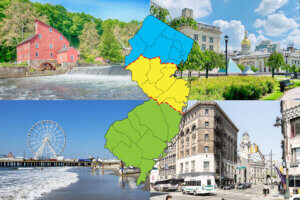West Long Branch, NJ – With the third anniversary of Superstorm Sandy’s landfall upon us, a new Monmouth University Poll finds that a large majority of New Jersey’s hardest hit residents remain more dissatisfied than satisfied with the state’s recovery effort, although the state’s signature recovery program, reNew Jersey Stronger, has seen some of its marks improve from last year to this year. These latest results come from the most recent installment of a panel survey that has tracked the experiences of those most impacted by Sandy over the past three years.
Specifically, just 4-in-10 (39%) hard-hit residents say they are very (6%) or somewhat (33%) satisfied with New Jersey’s recovery effort while 6-in-10 (61%) say they are somewhat (27%) or very (34%) dissatisfied. This year’s result represents just a minor improvement over satisfaction with the recovery effort in 2014 (33%) and 2013 (35%). A third of the survey’s participants (35%) say the state’s recovery effort is focused on helping people like them, which is slightly better than last year (28%) and 2013 (23%). However, two-thirds (65%) still say that people like them have been forgotten in the recovery effort.
“In many hard hit residents’ opinions, the state has simply not done enough to adequately address their most pressing needs. Three years removed from Sandy, the state still receives more negative than positive marks for the job they’ve done in the recovery effort,” said Tim Tracey, project director for Monmouth’s Sandy Recovery Survey, which has tracked the experiences of approximately 500 hard-hit New Jersey residents every year since the storm’s first anniversary.
There has been little to no improvement in satisfaction with the state’s recovery effort among those who are displaced three years after Sandy. Specifically, just 29% of these residents are satisfied with the recovery effort, which is essentially unchanged from last year (27%) and 2013 (24%). Satisfaction among those who are living in their pre-Sandy homes (43%) is higher, but even among this group the levels have increased only slightly from last year (35%) and is essentially unchanged from 2013 (40%). However, those who have been able to return to their home just in the past year (46%) have grown more positive in their views of the recovery effort compared to last year (31%) and 2013 (25%).
|
Satisfaction with New Jersey’s Sandy recovery effort | |||
|
|
2015 |
2014 |
2013 |
|
All Survey Participants |
39% |
33% |
35% |
|
by DISPLACEMENT STATUS |
|
|
|
|
Displaced |
29% |
27% |
24% |
|
Left home past year |
34% |
34% |
34% |
|
Back in pre-Sandy home |
43% |
35% |
40% |
|
Moved back past year |
46 % |
31 % |
25 % |
|
by RREM ASSISTANCE |
|
|
|
|
Approved for RREM |
46% |
35% |
29% |
|
Finished rebuild through RREM |
64% |
41% |
34% |
|
Still in RREM program |
34% |
31% |
27% |
|
Approved for RREM but no longer in program |
20% |
20% |
32% |
|
Denied RREM aid |
28% |
19% |
26% |
|
Did not apply |
37% |
39% |
46% |
|
by REBUILDING STATUS |
|
|
|
|
Finished within past year |
43% |
26% |
33% |
|
Finished over a year ago |
56% |
51% |
36% |
|
Started |
32% |
30% |
26% |
|
Have not begun |
17% |
14% |
19% |
|
Are not rebuilding |
13% |
24% |
25% |
|
by REGION |
|
|
|
|
Ocean County |
43% |
37% |
36% |
|
Monmouth Bayshore |
32% |
26% |
24% |
|
Monmouth Coast |
37% |
30% |
45% |
|
Other parts of New Jersey |
33% |
26% |
32% |
Currently, two-thirds (67%) of the survey’s participants report they are living in their pre-Sandy homes, which marks an improvement from last year (60%) and 2013 (54%). Another 12% this year say they are permanently displaced, up slightly from last year (10%) and 2013 (8%). Just over 1-in-5 (21%) say they are currently displaced and waiting to return home, which includes 11% who are staying in a temporary home or rental, 8% who are staying with family or friends, and 3% who are staying in a hotel or trailer. The percentage of residents who are living in a temporary home or rental has declined this year from last year (18%) and 2013 (24%). However, there has been almost no movement in the percentage who say they are staying with family or friends (9% in 2014 and 10% in 2013), as well as those who say they are living in a hotel or trailer (2% in 2014 and 5% in 2013). Interestingly, 8% of the survey’s participants report being displaced this year after having been in their homes last year when Monmouth interviewed them.
“The results in the latest round of our panel survey indicate there has been progress made in getting residents who were displaced from their homes back in, especially when compared to the displacement status of these residents a year after Sandy. However, as progress has been made over the past year in state assistance programs such as RREM, we’ve begun to see some of those who were in their homes last year reporting having to vacate over the past year,” said Tracey.
Last year, more than a quarter (28%) of those approved for RREM were stuck at the first step of the program, with less than 1-in-6 reporting that construction had either begun (11%) or had been completed (5%). This year, just 1% say they are at the first step in the process, while more than half say construction on their home has begun (21%) or is complete (34%) through the RREM program. However, about 1-in-7 (14%) of those who reported being approved for RREM last year are no longer in the program. Almost half (48%) of this group say they voluntarily withdrew from the program or gave up, 32% say they were since determined ineligible by the state, 10% accepted assistance from another recovery program, 7% were withdrawn by the state, 3% were determined ineligible by the state because they received an additional payout from their flood insurance claim, and 3% had their funding withdrawn because they did not finish rebuilding their home within the time frame allotted by the state. Another 7% mentioned “other” reasons. [ NOTE: Responses add up to more than 100% because multiple responses were accepted .]
The state has seen satisfaction with its recovery effort increase most significantly among residents who report having finished rebuilding their homes through New Jersey’s Rehabilitation, Reconstruction, Elevation, and Mitigation, or RREM, program. Almost two-thirds (64%) of this group say they are at least somewhat satisfied with the state’s recovery effort, which marks a significant improvement from how they felt last year (41%) and in 2013 (34%) when many of these residents were still in the rebuilding process. Those who were approved for RREM assistance but have yet to finish rebuilding their homes through the program are significantly less satisfied with the recovery effort (34%), and their satisfaction has remained almost unchanged from last year (31%) and 2013 (27%).
Looking now at satisfaction with the recovery effort by all residents’ rebuilding status whether through RREM or on their own shows a majority (56%) of those who finished rebuilding their homes over a year ago are satisfied, which is similar to last year (51%), but significantly higher than in 2013 (36%) when many had not yet finished their rebuild. Satisfaction with the recovery effort is lower among those who finished within the past year (43%), although it has increased noticeably from last year (26%), after decreasing slightly from 2013 (33%). Satisfaction among those who have started but not yet completed their rebuild is basically unchanged this year (32%) from last year (30%) and 2013 (26%). Just 17% of those who have not begun their rebuild are satisfied this year, which is similar to last year (14%) and 2013 (19%). Satisfaction among those who do not plan on rebuilding their homes is actually lower this year (13%) than it was last year (24%) and in 2013 (25%).
The state’s signature recovery program, reNew Jersey Stronger, has seen some of its benchmark performance ratings increase from last year to this year, although not significantly. Over half (55%) of residents who registered for assistance with the program say they are at least somewhat satisfied with the state’s responsiveness, up from 4-in-10 (42%) last year. Less than half (46%) say the program has done a good job keeping them informed about where they are in the process, which is up from 36% who said the same last year. Half (49%) say it has been at least somewhat easy to contact someone from reNew Jersey Stronger when they need information about their application, which is up only slightly from last year (42%).
Those who have now finished rebuilding their homes through the RREM program give the state better marks this year for their responsiveness (86% this year, up from 58% last year), keeping them informed (59% this year, up from 47% last year), and for being easy to contact when they have questions (64% this year, up from 53% last year). The program has seen much more tempered improvements this year among those who are still in the RREM program but have yet to finish rebuilding for responsiveness, (61% satisfied, up from 51% last year), keeping them informed (47%, up from 41% last year), and being easy to contact (54%, up from 46% last year).
Among those in the RREM program who have made it to the rebuilding stages of the program, three quarters (73%) say they are satisfied with their choice of builder, down from 93% who said they were at least somewhat satisfied with their choice of builder last year. However, it should be noted that there are significantly more residents in the later steps of the RREM process this year than there were last year when this question was initially asked.
|
Helpful in Sandy Recovery | |||
| 2015 | 2014 | 2013 | |
|
Family and friends |
89% |
88% |
88% |
|
Neighbors |
71% |
69% |
72% |
|
Community organizations |
56% |
56% |
50% |
|
State government |
50% |
46% |
40% |
|
Local town government |
48% |
50% |
49% |
|
Insurance company |
44% |
44% |
43% |
|
Federal government |
43% |
47% |
49% |
|
County government |
26% |
28% |
22% |
All participants of the panel study were asked to rate the recovery helpfulness of several different groups. Nine-in-ten (89%) rate their family and friends as helpful, followed by 71% who rate their neighbors as helpful. More than half (56%) rate community organization as helpful to their recovery, followed by the state government (50%), local town government (48%), insurance companies (44%), and the federal government (43%). County government is rated as helpful by only 26% of survey participants. Each of these results is no more than 6 percentage points different from results seen last year and in 2013, with the exception of the state government, which has seen its rating increase by 10 percentage points from 2013 (40%).
Those who were approved for RREM rate the state more helpful this year (74%) than last year (62%) or in 2013 (44%). Those who were denied assistance view the state government slightly more helpful this year (39%) than last year (33%), although this year’s result is now back in line with how these residents felt in 2013 (37%). The state’s rating has declined among those who did not apply for RREM, standing at 27% this year, down from 34% last year and 37% in 2013 (37%). The helpful rating among those who were in the program last year but are out this year (28%) is similar to last year (30%), but down considerably from 2013 (52%).
|
Easy to Get Recovery Information | |||
|
| 2015 | 2014 | 2013 |
|
Local town government |
40% |
38% |
42% |
|
Community organizations |
37% |
37% |
35% |
|
State government |
35% |
29% |
30% |
|
Federal government |
29% |
32% |
31% |
|
County government |
20% |
17% |
16% |
Just 40% say it has been easy to get information from their local town government over the past few months. Just a third of panel participants say it has been easy to get information from community organizations such as the Red Cross and Churches (37%), while a similar percentage say the same about the state government (35%). Three-in-ten (29%) say the same about the federal government, while just 20% say it has been easy to get information about the recovery from their county government.
About Monmouth University’s NJ Sandy Recovery Panel:
This release marks the eighth installment of findings from Monmouth University’s tracking panel of New Jersey residents who were hardest hit by Superstorm Sandy. Results from the first wave of the panel were released in October 2013, February 2014 and March 2014. Results from the second wave of the survey were released in October 2014. Monmouth has also released five polls tracking statewide opinion of the recovery’s progress over the past two years as well as a separate survey of New Jersey coastal residents’ post-storm views of rebuilding policies. Monmouth University’s Polling Institute believes it has produced more research on post-Sandy public attitudes and behaviors than any other group in the country. Monmouth’s reports can be found at https://www.monmouth.edu/polling-institute.
Methodological Note:
The Monmouth University Polling Institute conducted the Sandy Recovery Survey online and by telephone with New Jersey residents who were displaced from their homes for a month or more or sustained $8,000 or more in damage to a primary home due to Superstorm Sandy. The results presented in this report were based on interviews completed between August and September 2015. This survey is part of a panel study designed to track the experiences of New Jersey residents who continue to be impacted by the storm. The initial survey was conducted between September 2013 and January 2014 and the first follow up survey was conducted between July and October 2014.
The results presented in this report comparing changes throughout the three survey years are for 460 New Jersey residents who participated in all three surveys. The results reported for demographic sub-groups are among all 517 respondents who participated in this year’s survey. Because survey respondents were recruited using a variety of non-probability methods, the survey results cannot be statistically projected to the larger population of all Sandy victims in the state. The value of these survey findings rests in comparisons over time among the same group of residents to better understand individual-level recovery progress as well as for internal poll comparisons among different groups (e.g. variations between those who remain displaced and those who are now back in their homes, variations by income levels, etc.).
This project was designed to complement Monmouth University’s statewide and regional poll tracking of Sandy issues and specifically to highlight continuing issues in New Jersey’s Sandy recovery and provide recommendations for improving communication channels between hardest-hit residents and public/private authorities. This project was made possible by a New Jersey Recovery Fund grant from the Community Foundation of New Jersey and the Geraldine R. Dodge Foundation.
Survey Questions
1. Are you satisfied or dissatisfied with New Jersey’s Sandy recovery effort so far?
2. Which of the following best describes your feelings about New Jersey’s recovery effort? The recovery effort is focused on helping people like me OR People like me have largely been forgotten in the recovery effort
3. How helpful have the following been in helping you recover from Sandy:
Your county government?
Your local town government?
The state government, including the reNew Jersey Stronger recovery program?
The federal government, including FEMA and the SBA?
Charity/community organizations, such as the Red Cross and churches?
Your family and friends?
Your neighbors?
Your insurance company?
4. How easy or difficult has it been to get information about recovery and rebuilding from each of the following sources over the past few months:
Your local town government?
Your county government?
The state government, including the reNew Jersey Stronger recovery program?
The federal government, including FEMA and the SBA?
Charity/community organizations, such as the Red Cross and churches?
[NOTE:Questions 5 through 8 were asked only of those who had applied for assistance with reNew Jersey Stronger, (n=348).]
5. How satisfied or dissatisfied are you with the responsiveness of the reNew Jersey Stronger program, which administers programs such as RREM, LMI, and Rental Assistance?
6. How good of a job did the state program do in keeping you informed about where you are in the process?
7. How easy has it been to contact someone when you need information or answers about your application?
8. At any time did you lose your place on the list because certain documents or approvals were not submitted on time?
[NOTE: Question 9 was asked only of those who had chosen a builder through the RREM program, (n=154).]
9. How satisfied are you with the choice of your builder?
Click on pdf file link below for full methodology and results by key demographic groups.




